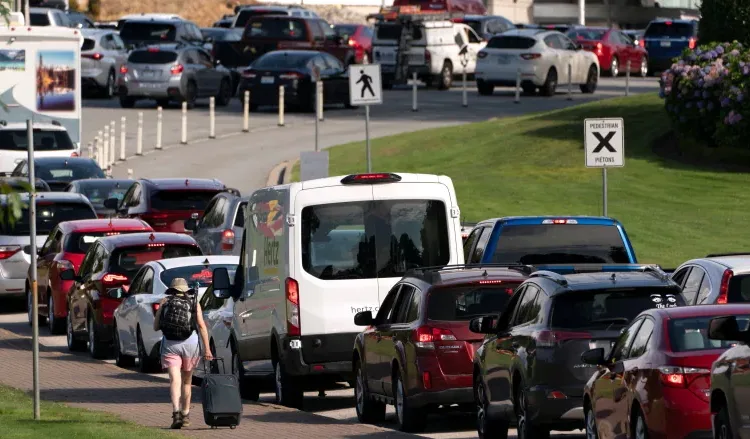Numbers still far below the level of crossings before the COVID-19 pandemic
The number of people crossing the land border into Canada more than doubled in the first week fully vaccinated Americans were once again allowed to enter the country for non-essential travel.
According to Canadian government statistics, 218,732 non-commercial travellers entered Canada by land from Aug. 9-15. The number, which includes both Canadians and Americans, was a 111 per cent increase from 103,344 travellers the week before, when the border was still closed to Americans, and a nearly 200 per cent increase over the 74,562 people who crossed during that same week in 2020.
It pales, however, in comparison to the 1.4 million travellers who entered Canada that week in 2019, before the start of the COVID-19 pandemic.
At the regional level, the government didn’t break down the numbers between non-commercial travellers and the number of truck drivers, which rose slightly that week. Including commercial drivers, who have been allowed into Canada throughout the pandemic, a total of 332,581 people crossed the border.
The region with the greatest number of people who crossed for commercial or non-commercial reasons was Ontario, which accounted for 206,783 of those who entered from the U.S. — up 54 per cent from the previous week. According to the statistics, the number of Canadians returning to the country nudged up to 111,210 from 101,214 the week before, but the number of “foreign nationals” nearly tripled to 95,573 from 32,520.
The Pacific region had the next-largest number of travellers that week, with commercial and non-commercial crossings into Canada rising 79 per cent to 52,875, from 29,530. While the number of Canadians rose to 20,579 from 17,492, the number of foreign nationals nearly tripled to 32,296, from 12,038.
The biggest percentage increase in travellers was in the Atlantic region, where commercial and non-commercial traffic rose 89 per cent, from 8,282 to 15,711. While the number of Canadians rose slightly to 5,981 from 5,234, the number of foreign nationals more than tripled to 9,730 from 3,048.
In Quebec, the number of commercial and non-commercial travellers rose 66.4 per cent, from 20,278 to 33,758. Again, there was a small increase in the number of Canadians to 15,768 from 14,018, while the number of non-Canadians nearly tripled to 17,990 from 6,260.
The Prairies had the smallest percentage increase that week, up 31.6 per cent to 23,454 from 17,819 commercial and non-commercial travellers. While the number of Canadians rose to 12,982 from 11,989 the previous week, the number of foreign nationals nearly doubled to 10,471 from 5,830. https://datawrapper.dwcdn.net/fWHU0/1/
The statistics also show an increase in the number of people who flew into Canada in that same period: 179,939 versus 138,257 the week before — a 30 per cent overall increase. But while the number of Canadian citizens flying into Canada was up 13.8 per cent, to 109,216, the number of “other foreign nationals” was up 67 per cent, to 70,723.
The same week a year ago, only 46,506 people flew into Canada, down sharply from pre-pandemic levels of 783,790 in that week in 2019.
On July 19, the Canadian government announced that it would open its border to fully vaccinated U.S. citizens and permanent residents who also had a negative PCR COVID-19 test taken within 72 hours of crossing the border.
On Sept. 7, that will open up further to include fully vaccinated travellers from other countries.
In the initial hours after the Canadian land border opened, there were long lines of cars and long waits at some border crossings as travellers jumped at the opportunity to come to Canada. Reasons for crossing varied widely. While some headed north for long-awaited reunions with family or friends, others came for tourism or to visit their cottages.
The United States, however, hasn’t reciprocated. While Canadians have been allowed since the beginning of the pandemic to fly in to the U.S., the Department of Homeland Security announced last week that the U.S. land border will remain closed until Sept. 21, citing COVID-19 transmission rates in the U.S. and the delta variant.
In recent weeks, the map from the U.S. Centers for Disease Control (CDC) showing community transmission across the country has grown redder by the day as county after county has moved into the category of high rates of COVID-19 transmission. The vast majority of counties that border Canada are now in the category of high or substantial COVID-19 community transmission.
Across the United States, 90 per cent of counties are now in the category of high COVID-19 community transmission.
According to the CDC, 51.6 per cent of U.S. residents are fully vaccinated.
While northern U.S. politicians and business leaders have called for the country to follow Canada’s lead and reopen its land border, the Homeland Security’s attaché in its Canadian embassy said during a conference last week that public health data was key in the decision in July to keep the U.S. land border closed.
“What really loomed large was the spread of the delta variant and all the unknowns about that, as well as trends on domestic public health dealing with things like vaccination rates, hospitalization rates, new infection rates,” Ted Sobel told the annual summit meeting of the Pacific NorthWest Economic Region. “So those are the things that we’re looking at very closely.”


